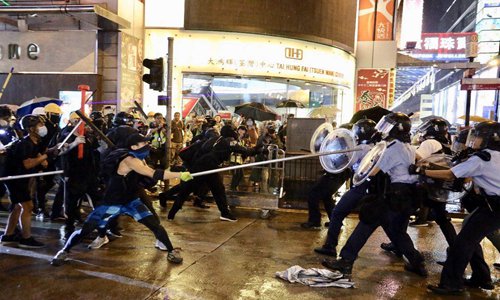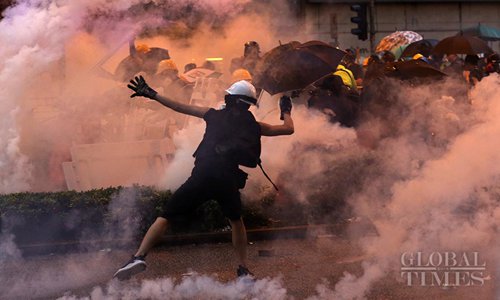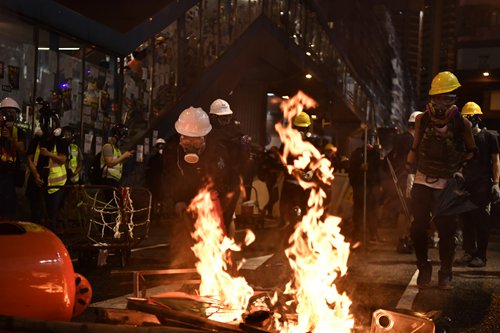How did mobs plan riots in Hong Kong?
Synchronized collusion behind series of violent incidents

Groups of rioters violently attack police officers along Sha Tsui Road in Tsuen Wan after illegal assembly on Sunday. Photo: Web
Rioters in Hong Kong have created many vicious incidents in the name of demonstrations in the past two months, including vandalizing the Legislative Council (LegCo), storming the the liaison office of the central government, disrupting the airport, besieging and beating tourists and a reporter from the Chinese mainland and even attacking police.
As their slogan of "peace, reason and nonviolence" and what they called "valiant" rioters took turns to debut, the claim that there is "no unified commander-in-chief" for their violence becomes more and more suspicious.
After more than two months of observation, the Global Times reporters found that a series of violent incidents taking place in Hong Kong Special Administrative Region did not appear to be so loose.
On the contrary, the mobs were extremely maliciously organized.
Main communication tools
"Christmas and the New Year are coming, let's prepare some 'gifts' for those nasty pigs and chimpanzees!" This message was circulated on a chat group on Telegram on December 6, 2016.
Two weeks later, a truck drove into a crowded Christmas market in Berlin which killed 12 and injured 49.
No one could have imagined that the social network Telegram has now become the main tool for Hong Kong rioters.
"Scott Scout certified guard information channel" is a group of Telegram with over 140,000 members and its introduction stated that the group aims to provide objective on-site information and intelligence to ensure the normal flow of blocked messages on the spot.
The group also claimed that this channel does not offer or obstruct any action, and all actions are decided by protesters on the site.
And in many of the riot, someone from the group would tip those other mobs off, and every action and deployment of the Hong Kong police would be found from the group accompanied by live pictures and exact locations.
In another group, someone would post locations for supply collections such as helmets and potions early before the riot, and then would post pick-up location for mobs who were ready to retreat after the riot.
It's reported that when two Telegram users communicate, a third-party or even the administrators cannot access their communication content.
When a user is engaged in a secret chat, the multimedia-related message will be designated a "self-destructing message," which means that the message would be automatically destroyed within a specified time after being read by users. And once expired, the message disappears on the users' devices.
The Global Times reporters have learned that a Telegram group could only have a maximum 200 members at first, but groups with over 20,000 members are not rare in today's Hong Kong.
The "self-destructing" function increases the difficulty for police search, making Telegram a hotbed for terrorists and crime. In fact, countries including Russia, Iran and Indonesia have long banned the use of Telegram for security reasons.
Hong Kong police detained a 22-year-old man on June 11, after he allegedly colluded with other members of a Telegram group to plan to storm LegCo and block main roads.
An online discussion forum, LIHKG, provided another gathering place for Hong Kong rioters. Observations from the Global Times reporters showed that rumors and sentiments are everywhere on the LIHKG, while reason and common sense are extremely absent.
"Telegram is for contacting and planning, the LIHKG is for inciting people to participate and Facebook is for promotion," an insider told the Global Times.

Photo: Cui Meng/GT
Clear division of labor
When online organizations turn into offline actions, the riots reveal a pattern. The Global Times reporters found that most important demonstrations are scheduled in the afternoons, as one important reason is that most young people who are having summer holidays have difficulty getting up in the morning.
If a bigger violent action was scheduled the next day, someone on the previous day's demonstration would chant "Meet on XX Date XX location" to persuade protesters to disperse early.
According to Hong Kong law, organizers of the demonstration must apply for a letter of no objection from the police before their rally and police decide whether to grant the letter based on assessment of the security situations.
Demonstrators have to strictly follow the specified location and time shown in the letter for their march once the letter is granted.
However, since June, the letter of no objection has turned into a piece of waste paper for Hong Kong mobs who end each action with violence and vandalism.
The Global Times observed that mobs usually adopt the strategy of "daytime peace, resorting to violence after the night."
Some Hong Kong residents reminded the Global Times reporters that there usually would not be conflicts at the starting point of the demonstration, and the demonstration turns violent when it comes close to the end and the sky is getting dark.
The Global Times reporters recently got an unsigned PDF document which details the riot strategy on the document's entire 41 pages.
The document is to assist all demonstrators, and it showed that someone has been summarizing the "experience" from Hong Kong's turmoil in recent years.
The content of this mysterious manual surprised the Global Times reporters as it has comprehensive and detailed explanations of the formation of police and evacuation methods.
For example, the manual listed methods to extinguish tear gas including using water or covering with buckets.
The manual clearly listed how to cover the windshield of water cannons with paint, but Hong Kong police first used water cannons only on Sunday in dealing with riots in Tsuen Wan.
The latest video program of the New York Times, "Meet Hong Kong's Teenage Protesters," explained how those black-clad protesters organize, assemble and cooperate in storming buildings.
A young man named "Ken" works at a grocery shop in the daytime and makes online purchases like helmets and goggles at night. Before each weekend demonstration, organizers of underground organizations take him and his peers to a hotel they called a "safe house."
Medical staff on the frontline of the demonstration and organizers of the demonstration show up at the hotel.
Everyone participating in the frontline demonstration is assigned a different task at the "safe house" meeting and Ken was assigned to throw eggs and stones at police stations or offices of pro-establishment legislators and monitor the deployment of nearby police forces.
Many high school students like Ken see what they did as live action video games. When night falls, these young people have a new identity which they are proud of.
Some rioters tear down roadside guardrails or dismantle construction facilities to block roads and then hold up umbrellas or swimming kickboards to confront the police.
Unconfirmed information circulated online showed that rioters spray strong stimulants on their masks to make them excited.
The Global Times reporters saw that some masked rioters kept screaming and commanding others to besiege passers-by who arouse their suspicion.
The mysterious manual also mentioned the formation that should be maintained in confronting with police.
Those "valiant" rioters would throw stones and iron bars at police or even besiege police officers when they outnumbered police.
Those "valiant" rioters do not worry that they may be in a passive position in public opinion, as some Hong Kong media outlets supporting the Hong Kong secessionists, such as Apple Daily and the Stand News, would glorify their actions and help them deal with the problems and the aftermath.
On Sunday, several police officers were attacked by rioters with umbrellas and iron bars after they blocked the police vehicle, and police fired a warning shot into air after their lives were threatened.
Seeing police pull a gun, a resident knelt to ask police not to shoot and was kicked by police and fell to the ground in a chaotic situation.
The mobs spread the cropped video of the incident on Telegram and the secessionist media also got "ammunition."
They focused on police holding a gun and kicking a resident, but they paid no attention to the dangerous situation of besieged police.
In addition to distorting facts to incite public sentiment, many secessionist media serve as "intelligence officers" for rioters.
They wear reflective vests with "PRESS" printed on them and blend themselves in with a bunch of reporters, but their eyes stare at police deployments and reporters from the Chinese mainland. The Global Times reporters saw a "reporter" tipping rioters off on a Telegram group.
More and more black-clad protesters take off their black clothes and pretend to be innocent residents in recent violence. They stand in the crowds to either offer rioters water, food or curse the police officers on duty to incite public anger and deepen public hostility toward Hong Kong police.

Rioters light fires as they gather in the Causeway Bay MTR station in Hong Kong on August 4. Photo: AFP
No commander-in-chief?
"No commander-in-chief" is what protesters have been claiming. It looks like those rioters do not follow any rules, but are their riots really "fragmented" and "decentralized?"
Protesters launched a demonstration named "the Hong Kong Way" on Friday evening which they claimed on social media to be self organized. Participants discussed the action steps only through social networking forums and encrypted Telegram.
The participants did not know each other's identity as the Telegram hides users' real name and contact information.
Before the demonstration, the Global Times reporters found the Google chart in their Telegram group, which could calculate in real time how many people in every single gathering spot and how many people were still needed.
Whenever new gatherings are to occur, a new large chat group will be set up on Telegram to help organize, coordinate and command various activities.
Global Times reporters saw a protest in the evening of Friday updated in a Telegram group in a real-time manner. When the protesters lined up on each side of the streets in Causeway Bay, someone in the group guided them to shout slogans.
When foreign visitors passed by, the group administrator then reminded them to change the slogans from Cantonese to English.
Some demonstrators dressed in suits and wearing masks were seen to command the protesters on site. They kept notifying the protesters when to shout slogans, when to open their mobile phones' flashlight, and when to raise their phones over their heads and wave to passers-by.
Though claimed to be with no organizers or no commanders-in-chief, such activities were well organized and skillfully coordinated online and offline.
"I don't think 'no commander-in-chief' is real," Hong Kong senior lawyer Ronny Tong Ka-wah told the Global Times on August 20.
There must be someone behind the protesters to provide resources and support, as the protesters which seemed scattered are actually well organized. They know how to take advantage of public emotion and irrational behavior well, Tong said.
"For example, when they did something anti-social, they would send young people to apologize the next day, saying 'Sorry, we went too far yesterday.' However, they would do the same thing again after the apology. This is their strategy," Tong said.
Hong Kong legislator Junius Ho Kwan-yiu also shared the same view. Ho sorted some materials of the Hong Kong riots, one of which recorded riots from the beginning of June to August 14.
"From the beginning of June to August 14, there have been 42 protests. If someone told you they were all spontaneous events, would you believe it? More than 40 large-scale demonstrations within about 60 days, without a commander-in-chief, it would not have happened," Ho said.
Hong Kong pro-establishment news website wenweipo.com said in a commentary in July that the riots were "without a commander-in-chief in name, but with a general commander in reality."
"Because the commander-in-chief 'does not show up in public,'" and the opposition groups also tacitly hide the commander, Hong Kong residents who participated in the demonstrations regarded the storm as spontaneous. Could it be possible that without a commander-in-chief, the protesters would have the strategy, resources and equipment and even the LegCo map, just relying on a few discussion forums, groups and webmasters?" said the commentary.
The headline of the article hints at a mystery. "Without a general commander, to who does Jimmy Lai Chee-ying report his work?"
Lai, the founder of Hong Kong-based newspaper Apple Daily, has long been accused of supporting Hong Kong riots and working with foreign forces.
Newspaper headline: HK mobs’ plan exposed